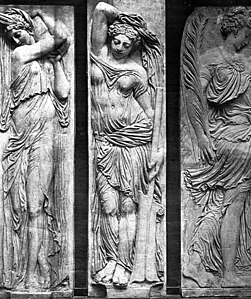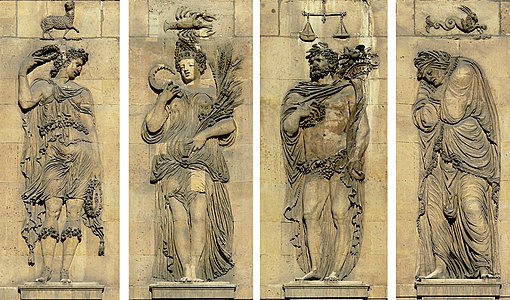Jean Goujon
Jean Goujon | |
|---|---|
 Statue of Jean Goujon by Bernard Seurre, located on the exterior of the Louvre | |
| Born | c. 1510 probably Normandy |
| Died | c. 1565, ~55 years old probably Bologna |
| Nationality | French |
| Known for | sculptor, architect |
| Notable work | Fountain of the Innocents, Caryatids of the Louvre |
Jean Goujon (c. 1510 – c. 1565)[1][2] was a French Renaissance sculptor and architect.
Biography
His early life is little known; he was probably born in
His most famous works are the sculptural decorations made in collaboration with Lescot for the western extension of the
The purity and gracefulness of his style were disseminated throughout France by engravings by artists of the
Goujon was a Protestant; he escaped the French Wars of Religion by exiling himself in Italy in 1562. He probably died in Bologna, where he is last documented in 1563 as a member of a group of Huguenot refugees.[1]
Works
His most famous works include:
- nymphs that decorate this public fountain designed by Pierre Lescot. The fountain is currently located - in a much truncated form - in the Les Halles section of Paris; original bas-reliefs are located at the Louvre
- Caryatids (1550–1551) - for the musician's platform in the Erechtheum in Athens.
- Allegories on the facade of the Louvre (1549-155) - these are found in the Cour Carrée (or "square courtyard") of the Louvre
- The Four Seasons (illustrations) made for the courtyard façade of the hôtel of Jacques de Ligeris, now housing the Musée Carnavalet, Paris.
To Goujon is usually attributed the engravings of the French version of Francesco Colonna's Songe de Poliphile (1546), based on the engravings of the original edition (which may be due to the studio of Mantegna).
The famous Fountain of Diana (Diana with a Stag) (c. 1549) Louvre, designed for Diane de Poitiers for the Château d'Anet, was long believed to be by Goujon or his workshop. It is now thought more likely to have been the work of Germain Pilon.[6]
Gallery
-
Stone reliefs of nymphs
from the Fontaine des Innocents -
Caryatides, Salle des Caryatides at the Louvre(1550–51)
-
Allegory of War, central pediment of the Lescot Wing of the Louvre
-
The Four Seasons (c.1547)
Musée Carnavalet, Paris
See also
References
- ^ ISBN 9781884446009.
- ^ A. de Montaiglon, documentary articles in Gazette des Beaux-Arts, 30 (1884), pp. 377-394, and 31 (1885), pp. 5-21, noted by Stein 1890:6, states Goujon died after 1572.
- ^ Goujon executed two columns beneath the organs, and bas-reliefs on doors.
- Musée du Louvre.
- bailliof 27 September 1555
- ISBN 9780300077483.
External links
- . Encyclopædia Britannica. Vol. 12 (11th ed.). 1911. p. 282.
- Works by Jean Goujon at the Art Renewal Center
- Imago Mundi: Jean Goujon
- Henri Stein, "Jean Goujon et la maison de Diane de Poitiers à Écouen", Annales de la Société historique et archéologique du Gâtinais 7 (1889), Paris 1890
- Lister, Reginald, "Jean Goujon : his life and work"(1903) London: Duckworth
Jean Goujon in American public collections, on the French Sculpture Census website




